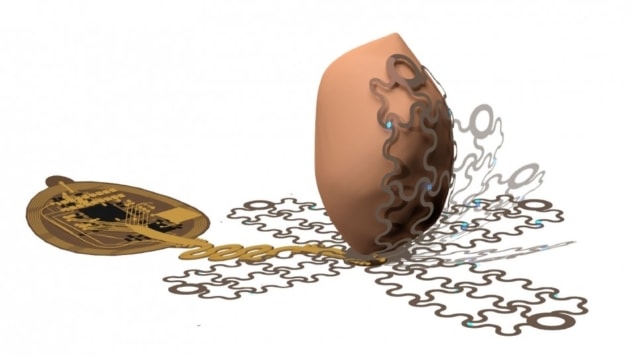
A wireless-powered implant that can detect and painlessly correct irregular heartbeats has been unveiled by researchers in the US. Led by Philipp Gutruf at the University of Arizona, the team based their design on a flexible mesh that surrounds and monitors the heart. Optical signals generated by an on-board computer are used to target muscle cells in the heart more precisely than existing pacemakers. This approach could lead to devices that are far more comfortable for millions who suffer from heart disease.
Arrhythmia is the abnormal beating of the heart, and it can be caused by a wide array of diseases. For many people, arrhythmia can be treated by implanting a battery-powered pacemaker/defibrillator, which monitors the heartbeat by detecting the electrical signals they produce. When signs of arrhythmia occur, the device passes an electric shock between a pair of leads that are connected directly to the heart. This stimulates muscle cells in the heart, leading to the restoration of a regular heartbeat.
Pacemakers have saved millions of lives globally but are highly invasive devices. Not only are the devices bulky and inflexible; the shocks they deliver also stimulate pain receptors in the heart.
Light-sensitive biomolecules
To improve on this design, Gutruf’s team explored an approach based on optogenetic stimulation. This involves stimulating light-sensitive biomolecules found in specific types of cells: in this case, muscle cells named cardiomyocytes. These cells are responsible for triggering the heart’s regular contraction, and crucially, contain a specific light-sensitive protein that is not found in pain receptors.
Powered wirelessly by an external antenna, the team’s design features a thin, flexible mesh that envelops the heart. The mesh monitors the organ’s electrical signals, which are analysed by an on-board computer that uses specialized algorithms.
If the computer detects arrhythmia, directs the mesh to send out optical signals that cause light-sensitive cardiomyocytes to contract in regular patterns. Since this light does not interfere with the electrical signals detected by the mesh, the device can continue to monitor the heart, even as life-saving optical signals are being delivered.
Targeted approach
According to the researchers, their design offers several advantages over conventional pacemakers. Its wireless power system removes the need to replace implanted batteries, which is currently done every five to seven years. Furthermore, the algorithms can be programmed to target specific types of arrhythmia – many of which require more complex treatments than existing pacemakers can deliver.

Temporary pacemaker regulates heart rhythm then completely disappears
Atrial fibrillation, for example, can cause the heart’s upper and lower chambers to start beating out of sync. If an algorithm could be trained to recognize this, the computer could tailor the optical signals sent out by the mesh, making the treatment far more effective and comfortable.
Having tested their device on the hearts of mice, Gutruf and colleagues are now confident that their approach could soon lead to a new generation of smarter, less invasive pacemakers. If achieved, this could ultimately improve the quality of life of millions of people currently suffering from heart arrhythmias.
The research is described in Science Advances.



